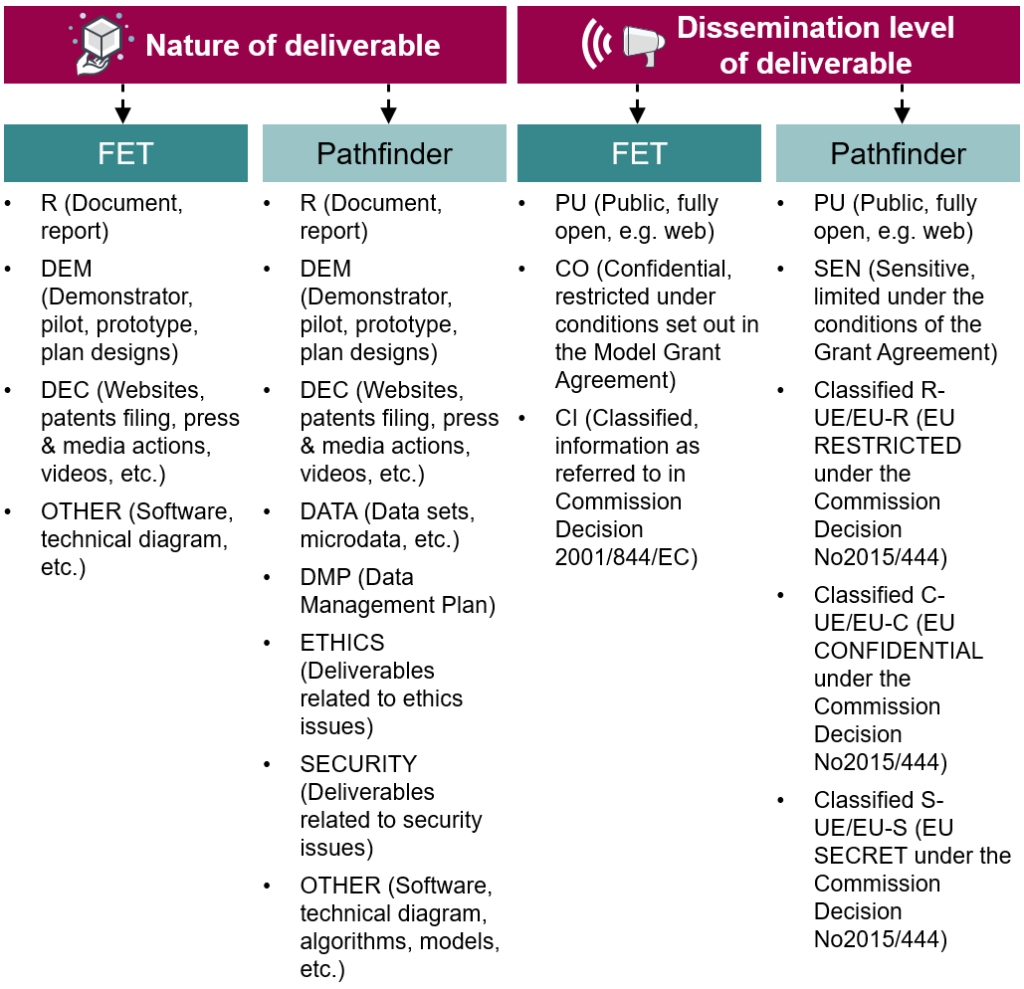Essential tips for your FET Open/ Pathfinder Open proposal (re-)submission
20th December 2021 at 6:28 pm
The successful EIC Pathfinder Open proposals in the first highly competitive call were selected for funding in November 2021 and the projects are set to start in the coming months. Given that only 56 out of 908 submitted proposals were successful, many applicants who scored highly might resubmit their proposals to the next Pathfinder Open deadline in early March 2022. We are delighted to be part of the positively evaluated 6%. Hence, in this blog post, we’ll be sharing our experience from both this very first Pathfinder Open proposal round and its predecessor, the FET-Open programme. When preparing the successful CORENET Pathfinder Open proposal with the coordinator of the ongoing FET-Open CLASSY project, Professor Andrés de la Escosura, we experienced several changes compared to its predecessor programme, the Horizon 2020 FET-Open, and familiarised with the new Pathfinder requirements.
If you’re considering (re-)submitting your innovative, breakthrough project idea to the next call or even if you’re just curious to learn more from our experience, read on as we explain some of the key changes related to the EC proposal requirements. This should help you assess whether your proposal fulfils essential requirements and all the Pathfinder specific aspects and decide on whether to make the substantial effort that goes into a relatively short proposal for a (re) submission).
Novelties in the Pathfinder Open
The Pathfinder is one of three programmes within the European Innovation Council (EIC), Europe’s flagship innovation programme designed to identify, develop and scale-up breakthrough technologies along the entire innovation chain. Indeed, while the Pathfinder Open and the Pathfinder Challenge programmes are dedicated to innovative solutions at Technology Readiness Level (TRL) 1-4, more advanced technologies at TRL 4-6 are funded under the Transition scheme and the SME-targeted Accelerator grant is awarded to technologies at TRL up to 8/9. While still targeted at breakthrough, innovative solutions, as was the case with the FET-Open, below we highlight a few of the main novelties in the Pathfinder Open proposal requirements, mostly related to the new approach of Horizon Europe. These range from the formalities of the main proposal document to the strict requirement of a multidisciplinary approach.
Novelty 1 – Part B format
The maximum length of the main proposal document is 17 pages, as was also the case for the FET-Open. However, the font size must be a minimum of 11 pt, also in the tables. Given that there are several mandatory tables, such as for the work packages, deliverables, milestones and risks, these now require substantial space. Like us, you might have used a slightly smaller font size for tables in previous proposals. Our recommendation is to carefully read the specific Part B template and the Guide for Applicants thoroughly to avoid any format and layout mistakes. Especially because this new rule does not apply for all proposal templates across Horizon Europe but is specific to certain calls.
Novelty 2 – Partner profiles in the online forms
In FET-Open proposals, the partner profiles formed the main part of the Part B2 document, which also needed to be uploaded to the EU portal as a PDF document alongside the Part B1 main proposal document. There was no page limit to Part B2, and applicants were able to demonstrate their expertise and experience without any restrictions.

In the Pathfinder Open, Part B2 no longer exists. Instead, each project partner needs to complete an online form on the EU portal as part of the revamped administrative forms (Part A). The fields to be completed are fixed by the EC, e.g., for the partners’ publications the details of their open access peer-reviewed articles are expected. As not all relevant publications for your proposed project might be open access, we would recommend also including those that, while highly relevant, may not be open access. Another difference is that there is no space foreseen to provide a short description of each partner’s institution and research group. The place to do so, yet briefly, is chapter 3.1 of Part B, meaning that out of the 17 pages available, there is less space for science.
Moreover, in the new online partner forms, you can only have one profile per beneficiary, i.e., legal entity, even for those partners participating with two or more research groups or departments. We find this to be a real disadvantage, as it`s now more challenging to show your scientific expertise.
Finally, once entered in the EU portal, the partner order cannot be changed, except by deleting all entries and starting from scratch again. (New) Partners can, of course, be added, and individual partners can be deleted, but new partners cannot be inserted at a preferred position without removing and setting up all subsequent partners from scratch again. In Horizon 2020, the partner order could be easily changed via drag and drop, while so far in Horizon Europe, one needs to decide on the final partner order before completing all profiles to avoid unnecessary extra work. Looking ahead at the next Pathfinder Open submission, we’re hoping that the useful drag and drop functionality will be available again.
Novelty 3 – Multidisciplinary approach ever more important
The development of breakthrough technologies typically requires the involvement of different disciplines. In CORENET, we combine systems chemistry, metabolomics, ICT and AI computing in a truly interdisciplinary approach. Although multidisciplinarity was already a requirement in FET-Opens, we feel that this has become ever more significant in the evaluation of Patherfinder Opens. For example, a project covering sub-disciplines of one primary discipline, such as software development, Artificial Intelligence and computing – all ICT, would not be considered interdisciplinary. The EC guidelines for chapter 1.4 of Part B state the following:
- Describe the proposed interdisciplinary approach engaging contributions from different scientific and technological disciplines.
- Explain to what extent the combination of disciplines brings new scientific collaborations and how it contributes to the achievement of the proposed breakthrough.
Thus, we recommend that you build your Pathfinder Open consortium by ensuring the complementarity of partners from different disciplines.
Novelty 4 – Updated deliverables categories
In the list of deliverables (table 3.2c in chapter 3.2), you still need to indicate the nature and dissemination level for all planned deliverables. However, the categories have changed for both, and new ones have been added as shown here.

During the grant preparation for FET-Open projects, we experienced several coordinators being asked by the EC to make more than half of the deliverables “public”. Especially in basic research in areas where patenting is critical for the protection of IP, this caused conflicts of interest and was subject to discussion. In Pathfinder projects, it remains to be seen what the EC`s expectation is.
From FET to the Pathfinder – our track record
While there are more novelties to look out for in the Pathfinder Open than what we’ve summarised above, we hope these basic yet important highlights will help you avoid last-minute surprises during your proposal preparation. Since the introduction of the FET programme in Horizon 2020, we have supported the preparation of several successful FET proposals, including Lumiblast, Pre-ART, FRINGE, CLASSY and SciFiMed. Our success rate is more than 60% in what is known to be one of the most competitive EU research funding schemes to date and we were very pleased to also achieve a successful outcome with CORENET in this very first Pathfinder Open experience. With many years of proposal writing experience, we can support you throughout your application process and during the implementation of your funded Pathfinder Open project, as we’re currently doing for CORENET and the FET-Open projects CLASSY, FRINGE , Lumiblast, as well as the FET flagship project macQsimal. Covering the areas of cheminformatics, systems chemistry, cancer therapy and quantum metrology and sensing, these projects are a good representation of our focus areas (Health and the Life Sciences, Energy and the Green Deal) and the breadth of other technology areas in which we have been involved over the years.
Are you interested in increasing your chances in this highly competitive scheme? From FET-Open to EIC Pathfinder, our taste for project ideas that are challenging current paradigms stays the same. Have a look at our Proposal Writing services and contact our EIC Pathfinder experts to discuss how we can best support you with your ambitions.

Jacqueline Strehler
Research & Innovation Project Manager

